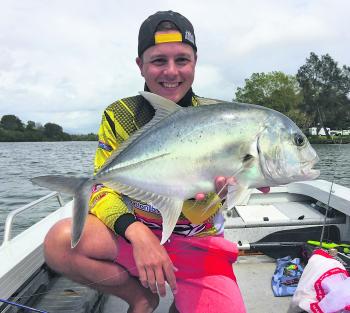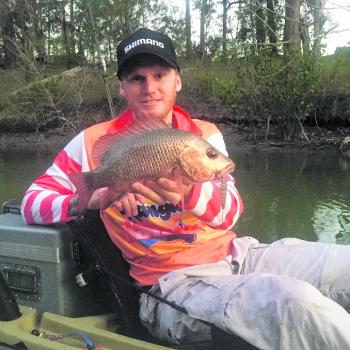I can’t believe we are heading into the New Year and planning our 2016 already! The stars have aligned for a cracking season of fishing ahead. The little black marlin have been working their way down the coast and now we just need the twitchy current to remain inshore long enough to keep them here.
These guys are super fun for the inshore angler, as we don’t get to see many of these ‘mega garfish’ throughout the rest of the year. The inshore run of blacks ranges between 20-50kg so most inshore light line tackle will do the job. When the marlin are thick you’ll be able to get them trolling hardbodies, throwing stickbaits, working a jig or even possibly on the old paternoster rig. As long as you find the warm water and the bait, they’ll be there. If they’re thinner on the ground, live bait will be the most assured way to target these top predators. Live slimies, yellowtail or small little bonito are perfect little marlin jellybeans. If the mackerel are around and you’re specifically targeting marlin then a yellowtail would be the go-to bait. Mackerel generally prefer the slimies and bonito, so a yellowtail will hopefully give you more time to pick up a marlin before a mackerel smashes your rig. If you are chasing the mackerel then know that the slimies are number one on their dinner list. Usually at this time of year, schools of slimies are easy to find, and it’s just a matter of catching your livies and throwing them straight back out on the line. There’s no point in locating a bait reef and going to the effort of catching your bait there only to fish miles away in deeper ocean. If there’s bait on the bait reef then that’s where the mackerel are too.
This time of year is great for targeting mackerel on lures. Stickbaits, like the Maria Fully Loaded and the Sebile Stick Shad in the sinking versions were the hits last year. Any decent sinking stickbait will do the job as long as you can get it to sink into the baits schools and be able to walk it out again. The mackerel lures don’t have to be as heavily rigged as kingy or GT baits, but cheaper lures will risk losing a good fish. Stickbaits are also the easiest lure for chasing mackerel off the stones. These same lures were responsible for many good mackerel this time last year.
Muttonbird Island, the South Wall and other deepwater headlands all have schools of mackerel doing the rounds. If you can get up to high ground during good conditions you’ll even be able to sit and watch schools come in and follow a route. If you can nail down the route they come through, then you can set up ready to have a cast at them as the schools come through.
For those not blinded by the pelagic frenzy that occurs at this time of year, the snapper and kingfish are still biting well and will sit under the same bait balls that are peppered from above by the crowd of mackerel anglers. Slow pitched jigs, plastics and live baiting under these schools has been doing very well, and there have been some unstoppable fish hooked but not captured on the deeper reefs recently. A bit of berley and some really big live bait are your best tactics for targeting a big hoodlum this month. You will also have the added chance of bonus cobia by-catch. As with any fishing throughout the back half of summer, if you don’t have wire on you risk losing your gear if the mackerel come around.
On the other end of the spectrum the trout fishing has faired reasonably well so far, considering the heat and lack of rain. The hot paddock streams are still worth avoiding as most of the fish will have moved or are sulking in the coolest spot they can find. The forested streams are still fishing well and with the warm weather most fish have been more than happy to slurp and dry fly or surface lure off the top. The route along Waterfall Way has been getting a lot of attention, so if you can find creeks away from the main drag then your effort should be rewarded. As you come further back down the hill, but still in the fresh water, the bass have become very active on the surface, even in the daytime. Surface crawlers and other cicada imitations have been the favourites.
Lastly, just a note that the NSW Research Angler Program that I’ve mentioned in previous issues has been expanded. Previously the program solely accepted mulloway frames, but will now also collect legal sized frames for dusky flathead, tailor, snapper and yellowtail kingfish. If you are keeping any of these species for a feed, consider donating your frame to this program and you can find out how old your fish was and where it sits within the rest of the captured fish data. Visit this website http://www.dpi.nsw.gov.au/fisheries/recreational/researchangler to find out drop-off locations and the details of what is required for donations.
For those of you visiting the Coffs Coast, just a quick reminder that a NSW fishing license is required for all fishing unless you’re exempt, so make sure you jump on the DPI website and sign up so your fishing trip doesn’t turn into a very expensive one. No matter where you’re from or where you’re fishing, I hope you have tight lines and good times.
Reads: 1461
Unfortunately for Rob Gaden, even a GT this big was still only worth 5 points in the Berkley Urunga Flathead Tournament.

Dayne Taylor hasn’t stopped talking about this bream he caught down in the Kalang River.

Get stuck into the hard fighting mangrove jacks this summer.




